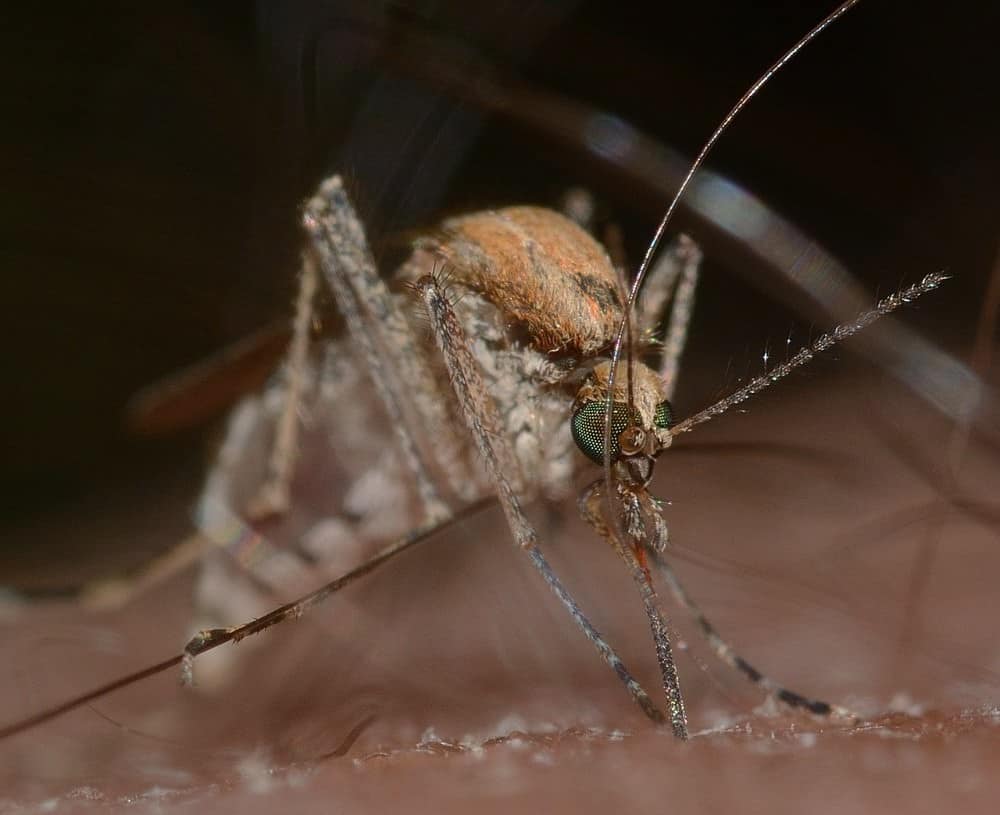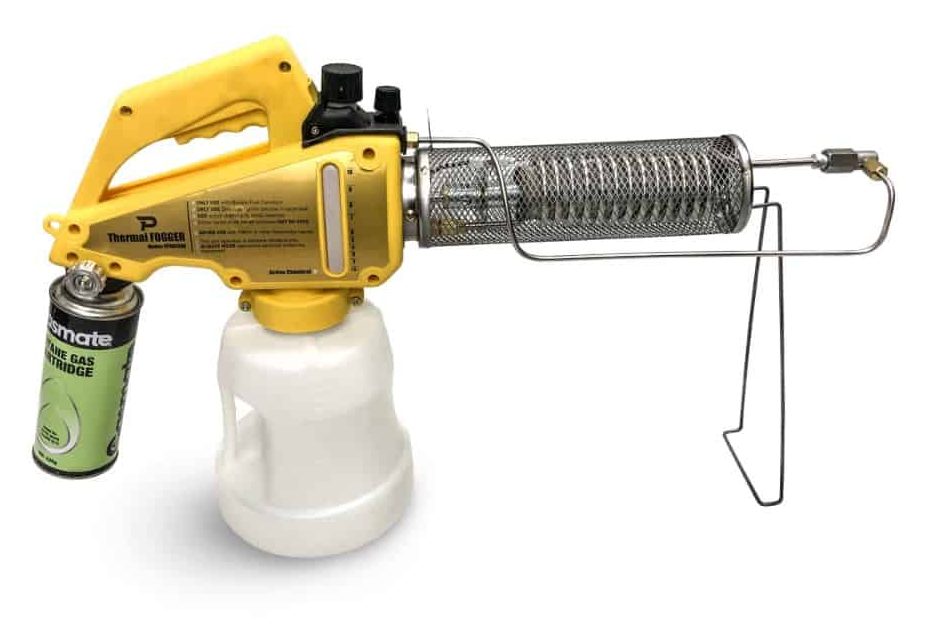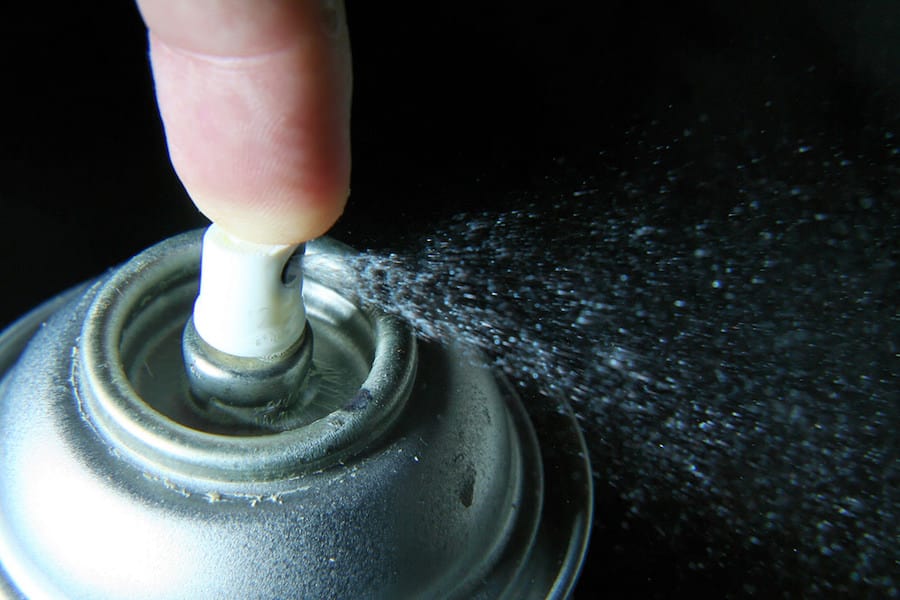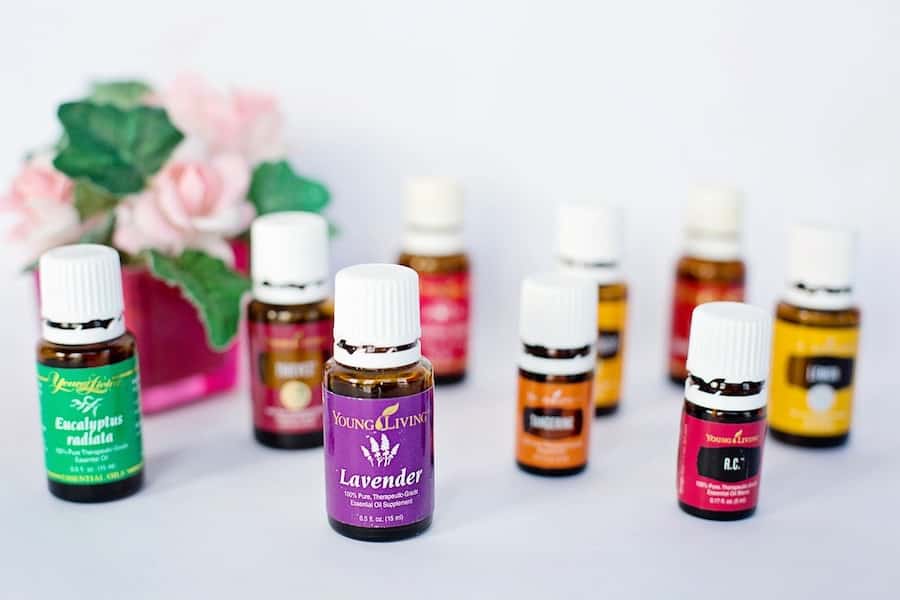Best Mosquito Killers
It can be difficult to choose the right mosquito killer for your particular needs. In this review, I will cover the different options you have when it comes to getting rid of these pests. You’ll learn about the best products available and how they work.
You will discover potential risks to be aware of and precautions to take. Finally, I will provide you with other techniques of controlling mosquitoes on your property.
Types of Mosquito Killers and How They Work
Zappers/Traps
Zappers and traps can be used both indoors and outdoors. These gadgets attract adult mosquitoes and then kill them.
Zappers
Zappers make use of special light to draw in mosquitoes. The light is surrounded by an electric grid. Mosquitoes approaching the light will be electrocuted.
For best results, the electric grid should be of a high voltage. This guarantees that mosquitoes are killed rather than just being stunned.
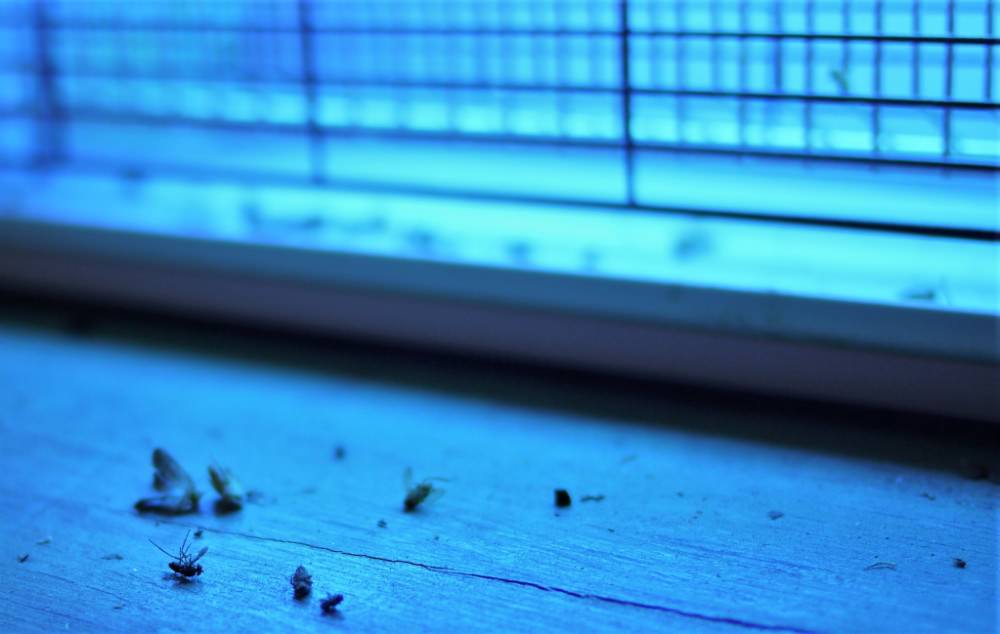
Black lights and LED lights entice both male and female mosquitoes. Zappers are environmentally friendly as they use only electricity, no chemicals are needed.
These devices come in a range of forms. Different strengths of bulb are used, depending on the design. Some are intended to attract mosquitoes in large areas or outdoors. Others are small, for indoor use.
Zappers do need occasional maintenance. You will have to change the bulbs periodically and you also need to regularly clear the zapper of insect corpses.
They work best if placed slightly away from the area you will be in. If the zapper is too close to you, the mosquitoes may be more attracted to you than the light.
Traps
An insect trap makes use of bait that attracts the targeted insect. The bait will vary, depending on what insect the trap is intended for.
Only the female mosquitoes bite us and certain species require blood meals to produce eggs. The females can sense where we are by different cues. These include smell, sight, and temperature.
Studies have shown that females are sensitive to the smell of carbon dioxide. Our exhalations are what entice the mosquitoes to our location. If they smell it, they actively pursue it.
Some commercial mosquito traps operate on electricity. They exude carbon dioxide, usually with a fan. Mosquitoes attracted to the scent end up trapped, usually in one of two ways.
The trap can use adhesive boards. When the mosquito lands, she will be stuck and, eventually, she will die. Other traps use a fan with suction. When the mosquito gets close enough, she is sucked in and killed.
These traps are capable of effectively reducing mosquito infestations. One study revealed 70 percent of targeted mosquitoes outdoors were attracted by traps.
They are also an environmentally-friendly mosquito killer. Traps do not use chemical pesticides. They are not toxic to the environment, people or pets.
Mosquito traps, like the zappers, will regularly need to be maintained, for maximum efficacy. Mosquito corpses should be removed often. If the trap uses adhesive, this will also have to be replaced periodically.
As with zappers, traps should be placed at a slight distance from you. Humans will always be the preferred choice for the mosquito.
Foggers
There are three variations of foggers. The first type is commonly referred to as a ‘bug bomb’. These foggers work by fumigating an entire area with a toxic substance, to kill off mosquitoes. With bug bombs, you do not have to directly handle chemicals. You activate the device and clear the area as it releases aerosol propellants.
Generally, bug bombs are employed by pest control experts. You will typically have to vacate your home for several hours or more. The chemicals are spread around the affected area in this manner. After staying in the air for a short while, they eventually begin to settle. Any mosquitoes in the vicinity are killed on contact.
These bug bombs typically release pesticides that are diluted rather than pure. This is because fumigating with a concentrated pesticide is dangerous. When used correctly, foggers should be hazardous only to pests. Bug bombs contain flammable chemicals. They should never be used near potential sources of ignition.
The second category of fogger is the thermal insecticide fogger. This is a gadget that is usually portable and dispenses a fog of insecticide.
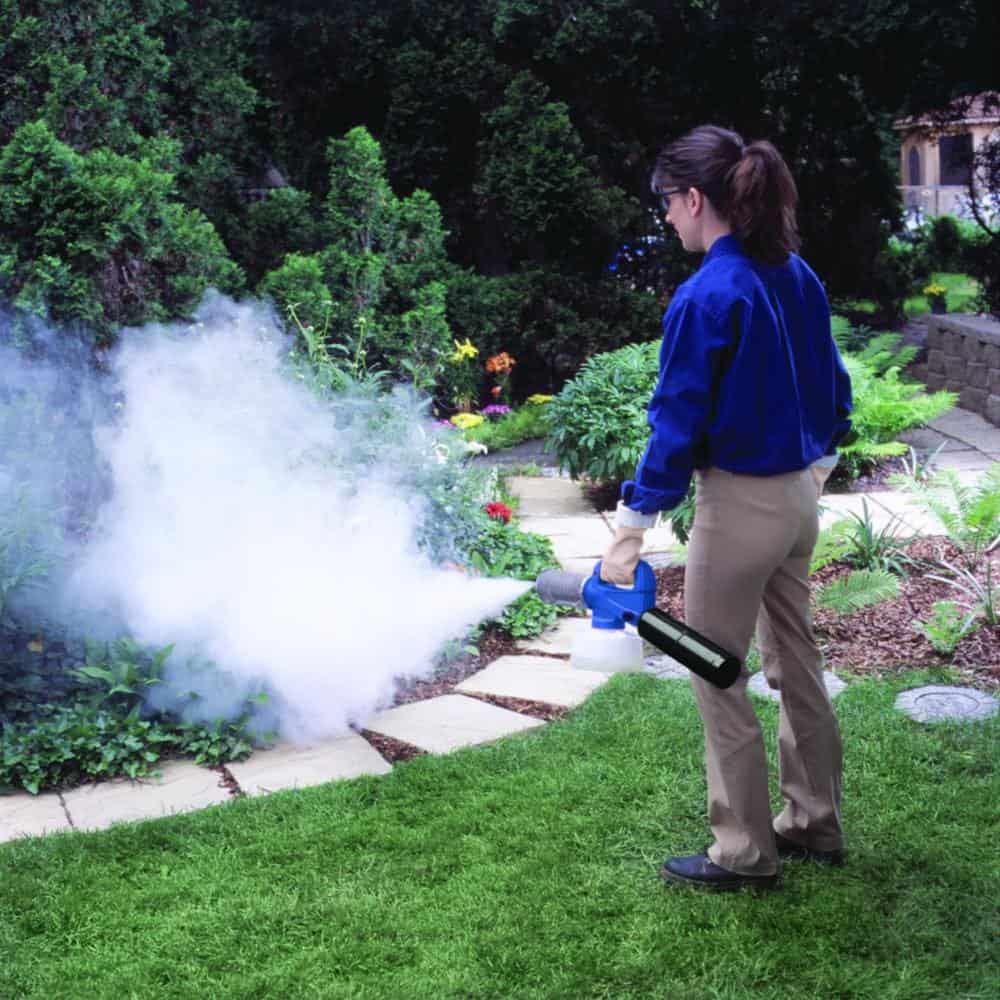
These can be fueled by propane or electricity. Insecticide is placed in a container that is attached to the fogger. There is a coil inside the fogger that heats up.
The heat vaporizes the insecticide on contact. It will emerge as a thick fog through the nozzle of the fogger. Foggers can be manual or automatic. If they are manual, you will have to pump fog out in short intervals.
This chemical-laden fog will kill mosquitoes and other insects on contact. The fog is supposed to penetrate areas where adult mosquitoes rest and hide. For example, cracks in outdoor furniture or in vegetation.
Most of these foggers also have a repellent effect. The residue will keep mosquitoes away for several hours. Thermal insecticide foggers are used by pest-control experts.
There are also commercially available brands for use by homeowners.
The third fogger type is ultra-low volume (ULV). These foggers operate similarly to their thermal counterparts. Instead of heat, however, they use pressure or spinning discs to vaporize the insecticide.
As with thermal foggers, they are used both privately and by professionals. ULV foggers are often utilized by communities to control mosquito populations. Large versions of these foggers are attached to trucks. The trucks then pass through neighborhoods.
Best Mosquito Zappers
I have reviewed three of the top bug zappers available on the market. I will explain the benefits of each zapper, and how to use it.
LiBa Bug Zapper
The LiBa indoor insect killer is a capable indoor weapon against winged insects. This zapper targets mosquitoes, moths, and other flying pests.
This zapper is a compact rectangle with a sleek design, weighing approximately 4 pounds. Two black-light bulbs are installed behind a powerful electric grid. For safety purposes, a non-electrified grid on the outside prevents children or pets from injury.
LiBa’s bug zapper emits light on a wavelength of 365 nanometers. This is the unit of measurement we use to perceive light. Wavelengths that are shorter than 400 nm are not visible to the naked eye. These are known as near-ultraviolet light, or black light.
The light that falls into this category is a known attractant to certain winged insects, including mosquitoes.
LiBa’s bulbs are durable and do not require frequent changing. Even if your bug zapper remains on at all times, you can expect at least several months of use. You also receive two replacement bulbs free of charge with your purchase.
The electric grid carries 2,800 volts. Even large insects, such as moths or big flies cannot survive contact. This guarantees any delicate mosquitoes that venture into the zapper will be killed instantly.
Note that, due to the high voltage, you will know when an insect has been electrocuted. A sharp, loud pop will signal that a mosquito (or other insect) has fallen victim.
The LiBa bug zapper can be freestanding on a countertop or table, or placed on the floor. A sturdy chain is attached to the top to hang it by a window or on a door or wall. The protective wire caging ensures the zapper will not get close enough to burn or damage any surfaces.
The LiBa allows for easy maintenance. A tray covers the base of the zapper and catches the insect corpses. This tray can be removed to dispose of the bodies quickly and simply. You will not have to shake the zapper or scrape at it to clean it out.
To use the LiBa bug zapper, all you have to do is plug it in. You will need to use an extension cord if you want to hang the zapper in a location that is not close to a power outlet.
If you do have to change the light bulbs, take basic safety precautions. Turn off the device and unplug it first. Do not handle the light bulbs or electric grid for at least three hours after switching off. This is to ensure you will not get a shock from any residual electrical current.
Despite the fact that there is a protective wire cage on the zapper, you still need to be careful. Keep it out of reach of children or pets.
Flowtron FC-880 Diplomat Fly Control Device
The Flowtron FC-880 Diplomat fly control device is for serious mosquito control. It is made for industrial use, weighing in at 20 pounds. This versatile gadget can be used indoors and outdoors.
The Flowtron is an efficient method of keeping larger areas clear of mosquitoes. It is an alternative to using multiple smaller zappers.
The zapper is shaped like a large lantern, with UV lights at the center. It is effective at 360 degrees. The base and top are built of durable black plastic that will not crack or warp, even if left outside.
These materials allow the Flowtron to work in all climates. It is even resistant to rain. You have three options for setting up the Flowtron. It can be stood upright on its flat base or hung, horizontally or vertically.
The power cord on this device measures a generous 67 inches. Unlike other zappers with shorter cords, you are less likely to need an extension cord to use it.
Flowtron’s zapper comes with powerful UV lights. They are capable of controlling and attracting insects in a radius of up to 2,000 square feet. You can set it to work controlling mosquito populations anywhere, from your yard to a barn.
The lights on this zapper are rated at 40 watts each—high intensity. This provides the dual purpose of attracting more bugs and lighting up the area you use it in.
The electrical grid is chrome plated. Chromium (or chrome) is not only tough, but also resistant to corrosion. You will not have to worry about the grid rusting over time.
The grid is powered by an alternating current that generates 5,600 volts. Any insect that comes in contact with the grid will die instantly. Smaller insects, like mosquitoes, are destroyed almost entirely, leaving little remains.
Aside from the inevitable noise when an insect is electrocuted, the zapper operates quietly. You will not hear any humming or buzzing.
Corpses fall to the bottom of the zapper, which is removable. You can also hang the zapper horizontally, so that any insect bodies will fall from the grid to the floor. If you prefer to hang it vertically, you can also remove the bottom for the same effect.
Place this zapper at a slight distance away from areas where you spend a significant amount of time. The Flowtron’s lights will attract mosquitoes and other insects far and wide.
Bugs BBQ Indoor/Outdoor Bug Zapper
This zapper can be hung indoors or outside. It is built of black plastic that can withstand all sorts of weather conditions. It will attract and kill mosquitoes and other winged pests.
The Bugs BBQ zapper has a sleek, compact design. It is smaller than the average bottle of wine. Shaped like a lantern, the UV light is encased in an electric grid. It is unobtrusive enough to be used even in a bedroom.
Weighing in at less than 14 ounces, it is a little on the small side. Despite its size, the zapper is powerful. The electric grid operates at 800 volts and is capable of electrocuting and killing mosquitoes on contact.
One, high-intensity UV light bulb attracts mosquitoes from a distance. This operates at a wavelength of 365 nanometers. As we established earlier, this wavelength is ideal for attracting mosquitoes.
A thick plastic grid protects family members from accidental electrocution. However, mosquitoes can pass through easily.
The electrical cord for this zapper is 35 inches. It comes with a detachable hook you can attach to the top for hanging. If you prefer, you can stand it on a flat surface.
The base includes a tray for catching the insect corpses. This tray is easily removed for quick corpse disposal. As it is plastic, you can wash it too. You will also receive a small brush to clear out the tray.
Make sure the zapper is unplugged from the power before you change the light bulb. As this zapper is small, you will need to frequently clean out the dead insects.
Best Mosquito Foggers
Now for my selection of three of the most effective mosquito foggers available. Let’s find out how they work.
Burgess 1443 Propane Insect Fogger
The Burgess 1443 propane insect fogger is designed for outdoor use. Using this fogger, you will be able to kill off mosquitoes in your yard.
Burgess will keep your yard free of mosquitoes and other flying pests for up to six hours. A quart of insecticide will treat an area of up to half an acre.
You can choose which brand of insecticide to use with the Burgess fogger. Repel,
Cutter or Black Flag are all suitable options. The propane cylinders this fogger uses as fuel can be purchased at most hardware stores.
The insecticide is distributed in a fine fog—almost seven times as fine as mist. The finer the particles are, the wider the range of the insecticide. The fine particles can
infiltrate difficult-to-reach mosquito havens, such as heavy foliage.
This fogger is based on the same principle as devices that pest control professionals use. It is handheld and simple to use. As it is propane operated, it is wholly portable. The fogger weighs 3 pounds, making it easy to carry.
This device features a safety mechanism. A sliding trigger will lock into place to prevent accidental fogging.
The 40-ounce insecticide reservoir is detachable and simple to load. Fill it with your pesticide of choice and re-attach it to the fogger. Make sure that the reservoir is securely attached before use.
Read the guidelines thoroughly on the insecticide packaging. Take care while handling these chemicals, and always wash your hands afterward.
Replacing the propane cylinder is equally straightforward. Securely close the fuel valve at the back of the fogger and insert the cylinder. It fits into place by hand tightening. As with the insecticide reservoir, ensure it is well secured.
Always clean out the reservoir during refills. Do not mix different insecticides together or leave debris from outdoors in the reservoir.
When you are ready to begin fogging, all you will need is matches or a lighter. When lighting the fogger, keep children and pets at a safe distance. As you are dealing with flammable materials and chemicals, take safety precautions.
Do not set the fogger near flammable materials. Keep it level when you are ready to light it. Do not hold the fogger at an angle or place it on an unstable surface.
Turn the fuel valve one-quarter of the way, to release propane. To light it, hold a match or a lighter underneath the silver coil. This is located inside the mesh burner cover at the back of the fogger.
Allow the Burgess fogger at least two minutes to preheat. This step is essential for maximum efficacy. If you start using the fogger before it is fully heated, the insecticide will not distribute as well as it should.
Once the fogger is ready, stand 5 feet away from the location you want to treat. Make sure the wind is at your back rather than blowing towards you. Squeeze the trigger to release clouds of fog every few seconds.
The fog should emerge as dry and white from the nozzle. If you spot liquid dripping from the nozzle, your fogger has not yet heated up.
If the fog is tinged yellow, this is an indication that the pesticide is too hot. You need to pump faster to keep it passing through the coil without overheating.
Unlike other foggers, you will not have to evacuate your yard for a long time. Five minutes after you have finished spraying, it is safe to return. It should take you less than 15 minutes to treat a yard of 5,000 square feet.
Since the Burgess fogger is portable, you have many options. You can take it with you to camp or picnic. If you will fog a public area, make sure to warn other patrons first.
Bonide 420 Fog-Rx Propane Insect Fogger
The Bonide insect fogger kills mosquitoes living and breeding in your yard. It is a propane-operated portable fogger that will keep your yard mosquito-free for hours.
Weighing 5 pounds, the Bonide fogger is lightweight. It comes with a sturdy handle for ease of use. As it is fueled with propane, you can use this fogger almost anywhere.
You can select between two insecticides to use in this fogger. One is intended specifically for mosquitoes. The other is also effective against other insects, such as flies.
The insecticide reservoir is transparent. This handy feature allows you to monitor when it is time for a refill without removing it. If you are switching insecticides between refills, clean the reservoir thoroughly.
Bonide insecticides are appropriate for use on ornamental and edible plants. The pesticides will not leave any residue that could be toxic to animals or people.
The fog that this device produces is extremely dense. This enables it to penetrate areas where mosquitoes may be hiding in. This fogger does not deplete the insecticide quickly, so you will find a full reservoir will last you for a while.
The propane cylinders for the Bonide fogger can be found at most stores. When replacing the cylinders, take care that they are secure. Screw the cylinders in slowly to guarantee a correct fit.
Light the fogger on a non-flammable, level surface. Turn the fuel valve and place a flame underneath the coil.
Allow adequate time for the fogger to warm up before you start releasing fog. The tip of this device is heated for maximum insecticide distribution. Flames, rather than fog, can emerge if you start pressing the fog trigger immediately after lighting it.
For this reason, it is best not to use this fogger in very dry areas. Do not let the nozzle come into contact with dry vegetation (e.g. dry grass).
Similarly, set the fogger in a non-flammable area while it cools down after use. Keep the nozzle from touching any surfaces until it is no longer hot.
As the coil is located in a mesh cage, you will be able to see it after lighting. Once it has turned a bright red color, the fogger is ready to use. For best results, let it heat for at least five minutes.
Press the fog trigger every four to six seconds. If you are pumping too rapidly, the insecticide will not have enough time to heat up and vaporize. Slow down if you notice liquid, rather than fog, coming out of the nozzle.
The dense fog will travel quite a distance, especially if there is a breeze. If your yard is small, you may want to notify your neighbors before you begin fogging. Perform similar courtesies if you want to fog a public area such as a campground.
H3 Black Flag 190107 Electric Insect Fogger
The Black Flag electric insect fogger can be used against mosquitoes and other flying pests. It is an optimal tool to use around decks or patios. At 4 pounds, it is lightweight and easy to carry.
You can expect to be free of mosquitoes for up to six hours with this fogger. You will only have to stay out of the fogged area for five minutes afterward.
There are three brands of insecticide that can be used with this device. You can choose between Cutter, Repel, or Black Flag. The reservoir is detached from the fogger to refill or clean it.
Always clean the reservoir between refills. Check that no outdoor debris is in the reservoir before you re-attach it to the fogger. Use one insecticide at a time, do not mix them together.
As this fogger is electric, you can use an extension cord of any length. It is important to select the appropriate gauge, however. A gauge indicates the size and power of the cord. The wrong size can be too weak or too strong. Select a 10, 12 or 14-gauge cord.
To begin fogging, all you have to do is plug the fogger into an outlet. It is an ideal choice for those who are wary of propane.
Allow a minimum of two minutes for the fogger to preheat. While it is preheating, keep it on a level surface. Remove flammable items from the vicinity. If the fogger is not hot enough, the insecticide will not vaporize. You will spot it dripping out of the nozzle.
Take care not to tangle the cord while you are fogging. Always keep the wind behind you and keep family members and pets away until you are finished.
Squeeze the trigger every few seconds at a steady rate. A thick, dry fog should emerge from the nozzle. If you notice discolored fog, you are not pumping fast enough. The insecticide is heating up too rapidly.
When you are not using the fogger, lock the trigger by the handle. Only disengage the trigger when it is heated and ready for use.
How to Choose the Right Mosquito Killer for Your Circumstance
The right mosquito killer depends on the situation. The type and location of infestation play a role. Your preferences and family situation should also be considered.
Indoor mosquito killers differ from those used outdoors. Certain products are designed to kill adult mosquitoes. Others are larvicides, for using against mosquito larvae. Although mosquitoes can breed indoors, they usually prefer to do so outdoors.
Keep in mind that a mosquito larva, compared to an adult mosquito, is an entirely different creature. Mosquito larvae inhabit bodies of water or moist soil, depending on the species. They survive off organic waste in their environment.
You can find mosquito larvae in containers such as bird baths. If you have a decorative pond outside, it may be infested with mosquito larvae. You have two choices when it comes to killing the larvae. You can use either a bacterial or chemical insecticide.
Bacterial insecticides tend to be more expensive but less toxic to humans. These are live bacteria that work against mosquito larvae. These pesticides are strains derived from Bacillus thuringiensis subspecies israelensis (Bti).
When ingested by mosquito larvae, the Bti crystals have a fatal effect. They dissolve the larva’s stomach lining, preventing it from feeding normally. Bti’s are not harmful to plants either. They will not harm pets, or helpful insects such as honeybees.
Chemical larvicides are available in a range of forms. You can purchase pellets, liquids, granules or tablets. As with any larvicide, you should apply them on breeding grounds—e.g. a body of standing water.
There are numerous types and forms of chemical insecticides for adult mosquitoes. These often come in different concentrations depending on how they are being administered. A pesticide you purchase off the shelf is not going to be identical to the one used by a pest control professional.
If you do select a chemical insecticide, take precautions. They can be dangerous if misused. Follow the guidelines exactly as indicated. The labels on most brands will detail how to handle the product safely.
As mentioned above, foggers are useful for killing mosquitoes outdoors. You can select between electric and propane-fuelled foggers.
Mosquito traps and zappers are a non-chemical alternative. If you have curious pets or children, these might be a better choice. These are also ideal to keep unscreened patios and decks mosquito-free.
You should set the trap or zapper at a distance from you outdoors. This way, you can enjoy sitting outside without worrying about chemicals or pests.
Controlling mosquitoes should not be an uncomfortable ordeal. Your personal preferences play a role in deciding on the right mosquito killer.
For example, you may not feel confident handling propane. In this case, an electrically powered fogger will be more suitable for you.
You might have edible or fragile plants in your garden. In this circumstance, you do not want a toxic insecticide that leaves a residue.
Bug zappers can attract and kill insects that are not pests. If you do not want to kill insects like moths, these gadgets may not be right for you.
You could, of course, contact a pest control professional to get rid of mosquitoes. You can discuss potential options and decide on the best one for you.
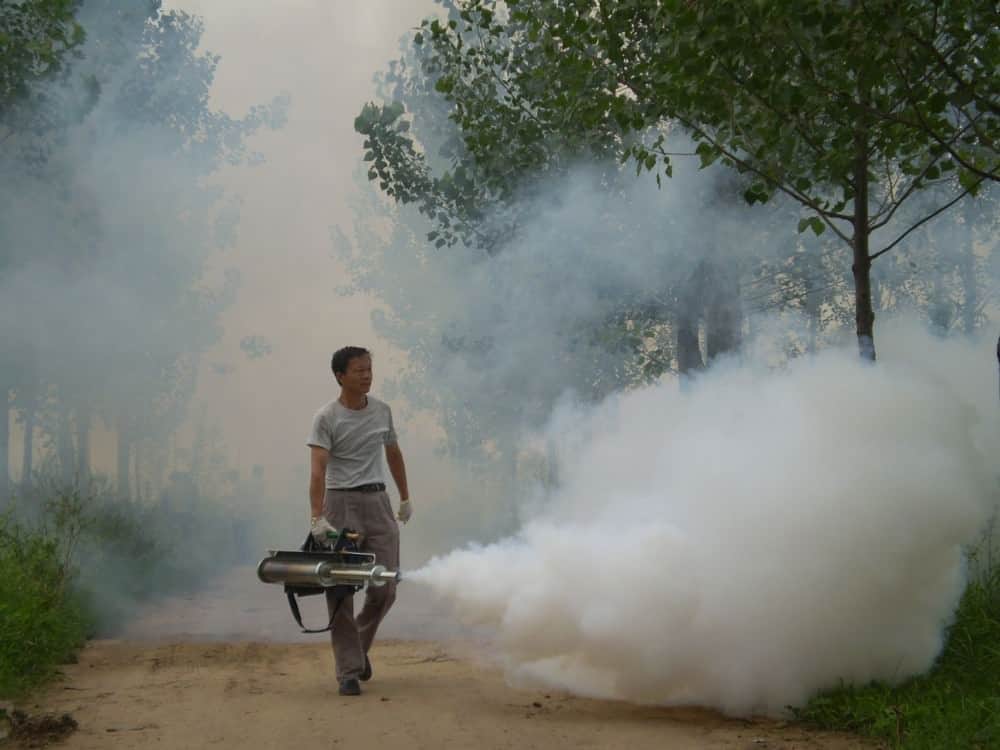
Other Mosquito Control Methods
You can control mosquito populations before they increase, and there are measures you can take to protect your property and family successfully.
The best approach to eliminating mosquitoes is multifaceted. Kill adults and larvae wherever you discover them. You should also prevent them from returning.
Indoor Control
Mosquitoes will take any opportunity to enter your home. Make sure that window and door screens are secure and undamaged. Even small rips can serve as entrances for these insects.
If you do not have mesh screens, avoid leaving windows and doors open. Use air conditioning or fans to keep your home cool instead. If you must leave the windows open at night, you should protect yourself.
You can purchase mosquito netting for your bed. When securing the net, make sure that it surrounds your bed. You should tuck it underneath your mattress and check that there are no gaps.
Remove potential mosquito breeding sites from your home. Check the garage and basement for standing water. Empty containers where water accumulates, such as plant saucers.
Outdoor Control
Neglecting your yard can lead to a mosquito infestation. You should take particular care if you have a pool or a pond.
Follow maintenance procedures for your pool. Keep filters functional and clean. If your pool cannot be screened in, use a cover. Empty the pool when it is not in use during winter months, if possible. You will have to apply larvicides regularly to a pond.
You may have to use this strategy with certain landscaping features. If water pools in a specific area of your yard, treat it with larvicides.
Larvicides should not be underestimated. Killing mosquitoes at this early stage will reduce adult populations around your property.
Mosquito larvae are also inherently vulnerable. These worm-like creatures require water to survive until they turn into adults. It is far easier to kill larvae than adults.
It is preferable to eradicate natural breeding grounds too. Tree holes can be filled up with cement. Ditches in your yard can be filled in with soil or sand.
Since mosquitoes are attracted to water, there are many containers in your yard where these insects can breed.
Bird baths, old tires, and buckets can fill with water. Even if water pools in an old toy, mosquitoes can lay eggs on it. If something is constantly collecting water in your garden, remove it if you can. Many species of mosquitoes lay eggs that require moisture. If these eggs dehydrate, they will die.
Do not leave your pet’s water bowl outside. Always bring glasses, plates, and garbage inside after dining outdoors. Mosquitoes can even lay eggs in a bottle cap if it is left unattended.
For other containers, store them correctly. Cover or turn over buckets and boxes, or take them inside. Replace the water in bird baths regularly. Use mesh or wire screens on rain barrels.
You can drill holes in tire or bucket swings. This will enable water to drain away after rainfall. If you have a septic tank, check it carefully. Seal any existing cracks or gaps. Any open plumbing pipes or vents should be covered with wire or mesh.
Adult mosquitoes rest in dark and humid environments. Keeping your yard neat can reduce resting spots. Clear away heavy vegetation or treat it with insecticides. Do not let piles of organic waste (e.g. leaves) go untreated.
Prevent Mosquito Bites
If you will be outdoors for long periods of time, try to avoid being bitten. Always https://pestseek.com/best-mosquito-repellent-spray/use a good mosquito repellent. Wear protective clothing (e.g. long sleeves) if you can.
You can apply some natural insect repellents to your children as well. However, you should follow guidelines carefully when using these products on a child. These repellents cannot be used on infants. Cover as much of baby’s skin with clothing as possible. Cover baby strollers and carriers with mosquito netting.
Risks and Precautions
When controlling pests, there are always risks. You should know the precautions to take before selecting a mosquito killer.
It is essential to prioritize the vulnerable members of your family. Infants and young children are more susceptible to insecticides than adults are. Your furry family members are also more at risk.
Young children and pets can accidentally touch pesticides in tablet or granule form. If you are applying chemicals inside your home, keep this in mind.
If you are using a chemical mosquito killer indoors, read the guidelines carefully. Even if an insecticide brand leaves no residue on hard floors, it may do so on a carpet. Your baby or young child could inhale dust or residue.
Even pesticides that are not toxic to adults may be dangerous for children. A crawling child can pick up chemical residue on their hands, which could invariably end up in their mouth.
Chemical insecticides may not be the best choice for pet owners either. Pets can end up accidentally poisoned. Curious cats or dogs can sniff, ingest or roll in insecticides.
If you are using mosquito foggers or spray, evacuate pets. Fish tanks should be kept covered during fogging or spraying. Do not re-enter the sprayed or fogged area until it is safe to do so.
Mosquito larvicides are intended to be applied to breeding grounds, ranging from ponds to bird baths. Do not allow your child or pet to play near bodies of water that contain chemical larvicides. Remember that these chemicals can also kill pond life.
You can select bacterial larvicides instead. Bacillus thuringiensis israeliensis (Bti) is non-toxic to humans and animals.
Insect growth regulators (IGRs) are also less harmful. These prevent mosquito larvae from developing normally. They do not affect humans, pets or wildlife.
If you do select a chemical insecticide, take precautions. Follow the guidelines exactly as indicated. The labels on most brands will detail how to handle the product safely.
Mosquito traps and zappers are non-chemical alternatives. However, these can also cause harm if handled by children or pets. To prevent accidents, set traps in locations children and pets cannot access. Hang zappers high up, out of reach.
There is one key rule to follow to avoid mishaps. Do not deviate from the product or device guidelines. These instructions exist to protect users from harm.
Do not use more or less of a product than directed. Never mix insecticides or chemicals together. Certain products should not be used simultaneously. If you are unsure, you can contact the manufacturer or your retailer, who should be able to help.
Be aware of the symptoms of poisoning in pets and humans. Nausea, vomiting, and fatigue can indicate poisoning. Other signs include difficulty breathing and skin irritation. If you suspect you have been poisoned, seek urgent medical attention.
If your pet is drooling or vomiting, it may have been poisoned. Take your pet for emergency veterinary care immediately.
Summary
Controlling and killing mosquitoes requires commitment. You can use multiple strategies at once for ensured effectiveness. Remember to practice good safety precautions. Know the risks of using the different methods available.
Now that you are aware of the various types of mosquito killer, you’ll be on your way to a mosquito-free environment.

